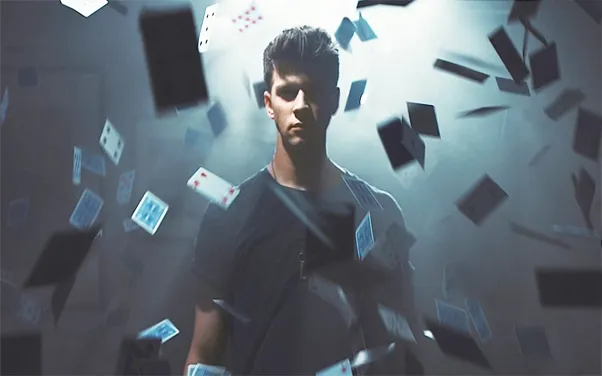Mathematical Illusions: Unveiling the Magic
In the quest to captivate and enlighten students about the marvels of Mathematics, our mission is to transform their engagement with this essential discipline. By introducing them to the enchanting world of magic tricks, we aim to spark their interest.
These illusions serve as a gateway to understanding the fundamental mathematical concepts that are the backbone of such tricks. Further, we explore how these identical mathematical foundations are integral to a wide array of applications, from the technology behind medical imaging to the mechanics of text messaging.
This approach not only demystifies Mathematics but also highlights its ubiquitous presence and critical role in our daily lives and technological advancements.

Download the full book or some sample tricks here:
Complete Manual of Mathematical Magic[ PDF 9.1MB ]
The Manual also includes bonus Maths Hustles…
Sample 4 The Napkin Game [PDF 366KB]
Sample 5 The Glass Challenge [PDF 384KB]
For other Maths, Science and Engineering related magic please visit:
www.illusioneering.org
Watch the Illusioneering Preview Videos:
The Art of Card Magic: A Mysterious Card Swap
In the enchanting world of card magic, there exists a trick that captivates audiences with its blend of mystery and potential harmony. This trick permits the magician to perform an astounding feat where a solitary card astonishingly switches locations under conditions that are both enigmatic and, at times, melodically influenced.

Mastering the Enigmatic Card Pairing Illusion
In the realm of card magic, engaging the audience with an act that combines simplicity and intrigue is key. The following routine is a testament to the magician’s ability to transform a straightforward setup into a captivating experience.
Setting the Stage
The illusion begins with a volunteer seated at a table, their hands positioned as though ready to play a melodious tune on the piano. The magician, equipped with a deck of cards, selects four pairs of cards in a deliberate, methodical manner.
The Initial Placement
With grace, the first pair of cards is delicately placed between the volunteer’s left hand’s third and little finger, accompanied by the magician’s remark, “Two cards, that’s one pair.” This process is meticulously repeated, with another pair slotted between the third and second fingers, signifying yet another duo. The sequence continues, with pairs being strategically placed between the remaining fingers, each time announcing the addition of “another pair.”
Transitioning to the Right Hand
Mirroring the actions on the left, the magician proceeds to the volunteer’s right hand, repeating the placement and commentary for each set of digits. However, a twist emerges when, upon reaching the final slot between the thumb and forefinger, only a single card is introduced, emphasizing its singularity with the phrase, “Only one card, an odd card here.”
The Revealing Process
As the routine advances, the magician embarks on a systematic removal of the cards from the volunteer’s hands, segregating them into two distinct piles while reinforcing the notion of ‘pairs.’ This meticulous separation continues until the solitary card’s moment arrives. This unique card is handed to the volunteer, who is then invited to place it atop either pile.

The Climactic Revelation
In a display of magical prowess, the magician taps the pile chosen by the volunteer, declaring that the singular card will mystically transfer to the opposing pile. This moment serves as the crescendo of the act, leaving the audience in awe of the seamless blend of precision and enchantment that defines the enigmatic card pairing illusion.

Mastering the Mystique: The Invisible Card’s Journey Uncovered
Gather the stack where the extra card was inserted. As you sift through, allocate the cards into adjacent duos, declaring with each couple formed, “Here’s a pair.” Joyously, you’ll discover four pairs, meaning the additional card has mysteriously disappeared!
To validate this magic, sort the cards in the second stack similarly, by pairs. Intriguingly, a lone card remains, suggesting the elusive card has stealthily made its way to the other stack!

The Art of Invisible Card Transport: Unveiling the Secret
In the realm of magic, the concept of a card invisibly shifting between piles through mystical forces often captivates the imagination. However, the reality behind this fascinating illusion is grounded in clever misdirection rather than supernatural powers.
Understanding the Mechanics
At the heart of this trick lies a simple numerical deception. The person assisting the magician holds eight cards (or four pairs) in their left hand and seven cards (three pairs plus one odd card) in their right. This setup is the foundation of the illusion, achieved through verbal sleight of hand, or as some might say, linguistic legerdemain.
The Illusion of Evenness
The trick progresses by dividing the cards from both hands into two piles. Each pile, now containing seven cards, appears to be even to the observer, especially since the magician emphasizes the pairing of cards throughout the trick. This focus on pairs leads the assistant to overlook the actual unevenness of the piles.
Revealing the Magic
As the magician adds a single card to one of the seven-card piles, it transforms into an eight-card pile, allowing for a perfect count of four pairs. This moment is where the audience is left pondering the fate of the seemingly vanished odd card. When the other pile, which remains at seven cards, is counted, it reveals three pairs and one leftover card. This discrepancy prompts the mistaken belief that the odd card has mysteriously traveled between piles.
A Lesson in Observation and Logic
This trick serves as a playful reminder of how easily our perceptions can be swayed by clever presentation and the importance of basic mathematical understanding. It underscores the idea that not everything is as it appears, especially when we’re inclined to take every claim at face value without critical evaluation.
In essence, the magic of the invisible card transport is not just a testament to the magician’s skill but also a fascinating demonstration of how easily human perception can be manipulated.

Bonus Hustle Effect 2 The Napkin Game
To kick off this intriguing game, start with a simple paper napkin. Unfold it completely to lay it flat. Now, take the corners on opposite ends and bring them together, trimming away any extra material so you’re left with a neat square. Proceed by joining the remaining opposite corners, which, upon unfolding, will reveal a square marked by diagonal creases that intersect right at the center. This marks the beginning of an engaging challenge.
Gathering Game Essentials: Coins of Uniform Value
For this game, ensure you have a collection of identical coins; two-pence pieces work wonderfully for this purpose. The objective is simple yet captivating. You and your opponent will alternate placing a coin on the napkin, with victory slipping from the grasp of the one who finds no space to place their coin without crossing the napkin’s boundaries.
Strategizing Your First Move: A Clever Opening Play
Here’s where the strategy begins. Offer your opponent the choice to play first or second. Should they suggest you start, place your inaugural coin right at the center of the napkin, atop the crease intersection. Conversely, if they opt to lead, politely introduce an additional rule: the game commences with a coin already placed at the center, after which it’s their turn. This ensures that regardless of the order, a coin will always occupy the central spot, compelling them to navigate the next move thoughtfully.

Unlocking Victory: Mastering the Art of Symmetrical Play
In the realm of strategic gameplay, your triumph is already at hand! The journey forward is a dance of intellect and understanding of symmetry. Each move your adversary makes is an opportunity for you to counter with precision, by placing your piece in a mirror position across the central piece. Imagine this: if your opponent decides to place their piece one centimeter away from the central piece at the top (12 o’clock), your response is to position your piece with equal distance on the opposite end, specifically at the bottom (6 o’clock).
The Strategy Behind Symmetrical Placement
This tactic relies on the principle that your opponent must act first. By setting the central piece yourself, you ensure that your opponent is compelled to make the first move thereafter. Your method of mirroring their placements guarantees that they will exhaust available space on the playing field before you. This isn’t merely about copying their moves; it’s about understanding and exploiting the principle of symmetry to secure your advantage. It transforms the game into a thought-provoking challenge: are you ready to test this strategy?

Understanding the Magic of Circumference and Diameter
The relationship between a glass’s circumference (C) and its diameter (d) is a fundamental principle of geometry, defined by the formula C = π x d. This equation reveals that the circumference is slightly more than three times its diameter. Interestingly, as most glasses widen at the top, their circumferences become significantly larger than expected, a fact not widely recognized.
Leveraging Diameter in Optical Illusions
This underappreciated mathematical fact provides a unique advantage. The average person may not realize the potential that comes with understanding that the glass’s circumference is essentially triple its diameter. This knowledge plays a crucial role in creating optical illusions. For instance, when viewing a letter “T,” its horizontal and vertical lines, despite being of equal length, do not appear so to the human eye. This visual discrepancy is a common cognitive mistake.
Applying Geometry to Everyday Objects
Visualizing a glass from the side illustrates this concept further. The top diameter appears shorter than the actual distance from the table to the rim, even when they are identical. This illusion, combined with the common misunderstanding of the C = π x d formula, allows for a fascinating experiment: stacking glasses on various objects without exceeding the rim’s circumference.
Executing the Perfect Demonstration
Before attempting this demonstration, ensure you’ve accurately measured your glass to know what items it can be stacked on while maintaining the illusion. Using a string to measure and demonstrate the circumference can make for a compelling and conclusive finale. Engaging with your audience is paramount. Introduce elements of surprise, such as placing a few decks of cards beneath the glass. If skepticism remains, add another deck reluctantly to appear defeated, only to reveal the truth with your string measurement, thereby showcasing the practicality of geometry in a dramatic and educational manner.

